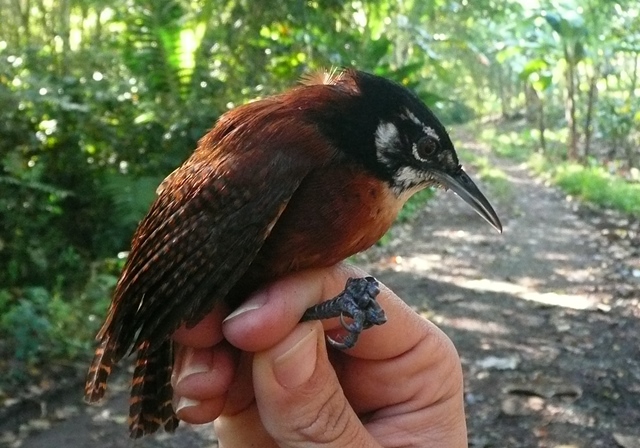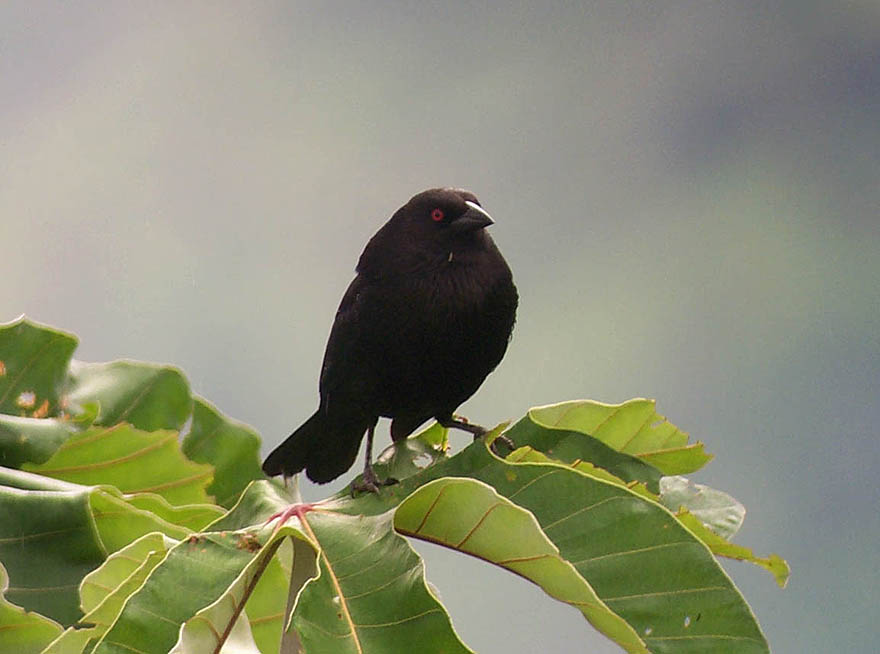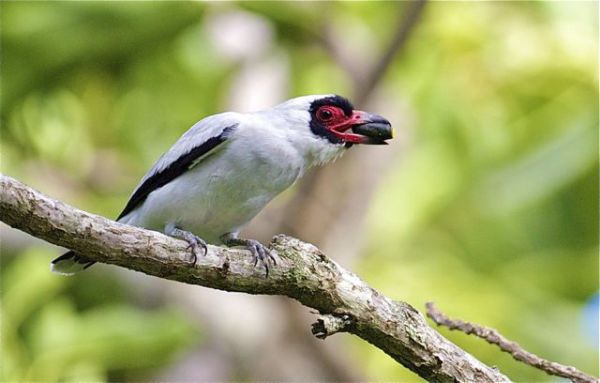This is a photo of the first Bay wren (Thryothorus nigricapillus) that I ever saw very well, captured and banded at CATIE in Turrialba. This week I finally saw (and heard) one close to home and reached a total of 150 species for my local bird list. It’s a Caribbean species and also one of the most beautiful of Costa Rica’s 22 wren species.
A clump of forest above Quebrada La Loca, and the bed of the stream (sometimes river!) itself have now become my favourite local spots for birdwatching. It’s a five-minute walk from home, and a neighbour, don Martín, kindly allows me to walk the path through the forest patch, which is on his property. Here is where he found the Fasciated tiger-heron that was the subject of an earlier post of mine. The tiger-heron has not, so far, reappeared, but the Sunbittern is a regular find and the solitude of the location, set among heavy vegetation ensures a wide variety of species.
Sometimes the place is silent and few birds can be seen, but almost always they can be heard and I am becoming gradually more adept at recognising their calls.
An early morning or late afternoon walk is best, but this weekend I was off down to San Diego for lunch with Chalo and Hannia and so decided to scramble down the river bed for the first part of the walk. In the brushy grass approaching the doctor’s house, there are now three little seed-eating species, Yellow-faced grassquit, Variable seedeater and Thick-billed seed-finch. The latter species, a recent addition to the local list, has now also appeared down at San Diego (970 m) at the cabins. The doctor’s bottle-brush trees hosted White-necked jacobin this time, but there was no sign of the Green-breasted mango that is also a frequent visitor there. Perched nearby were two male Bronzed cowbirds (Molothreus aeneus); bad news, I suppose, but I see very few in our area.
At don Martin’s cabin, the nesting Keel-billed toucans and Golden-hooded tanagers are still easily seen, but so too was a single Silver-throated tanager. This is a common species a little higher up at Santa Cruz. First impression is of a yellow bird, but the silver throat seen in good light makes it stunningly beautiful.
I spent quite a while in the forest patch, which is on the steep slope above the Quebrada, because I wanted to again get a good look at the Three-striped warbler (later determined to be Golden-crowned warblers) and the White-breasted wood-wren (Henicorhina leucosticta), two species that I have now found several times in that very shady. Here too I might again see the Bicolored hawk. Today, it was a family of wood-wrens. By simply sitting still for several minutes I was able to get excellent views. The first bird had not much white on the throat, and I was tempted to think that it might be the Gray-breasted wood-wren, its highland counterpart. Both should be found at this elevation, but I had never personally been absolutely sure of the identification. Good views of a second bird assured me that it was, indeed, the White-breasted wood-wren. For the time being, I have no access to a photograph, but if you pretend that the breast on the bird in the following photograph is white, you will get a good idea!
The lower part of the forested slope did not yield the Three-striped warbler this time, but the thick vegetation on the river bank itself contained several Common bush-tanagers (Chlorospingus ophthalmicus) (never seen in my garden), which I can usually find only at a slightly higher elevation. They seem to be here regularly, however. The white behind the eye is an easy field mark, but their twittering is a very faint noise for a bird this size.
Accompanying the bush-tanagers was the slightly larger but much louder Bay wren ( Thryothorus nigricapillus). I was fortunate to see it emerge briefly from the tangled vegetation on the sheer opposite side of the bank of the quebrada. This made it a red-letter day, because it’s my first record for this species here at San Antonio. A few minutes later, it burst into song from its new hiding place, easily overcoming the rushing noise of the river over the many rocks.
I was still looking for the tiger-heron but was happy enough to find a Sunbittern (Europyga helias). It flew off ahead of me, flashing the sun on its wings, as I clambered downstream over the river bed. This species seems now almost common in the area, often easy to find even in the very centre of Turrialba.
After twenty minutes of slipping and sliding over the rocks, I took the steep climb up through a grove of cypresses and onto the dirt road that leads to San Diego. The descent to San Diego is mostly open country, but at the side of the road I found a number of holes in the bank, one containing the nest of a pair of Northern rough-winged swallows (Stelgidopteryx serripennis). The parents sat watchfully and with evident concern on a nearby wire until I passed by. This is second most common swallow in our area, after the Blue-and-white swallow (Pygochelidon cyanoleuca). It is a plain bird but can be fairly easily distinguished from the Southern rough-winged swallow (Steligdopteryx ruficollis), because the latter has a very evident pale rump, plus a cinnamon throat, seen best when the bird is perched.
The only other bird of note before San Diego was the Dusky-capped flycatcher (Myiarchus tuberculifer), which is currently nesting here in greater numbers than in past years. Flycatchers in general present great difficulties for correct identification, but this species is really the only common Myiarchus here, and it is well-named because the head is noticeably dark. Lower breast and belly are very yellow. Other Myiarchus flycatchers in Costa Rica are also on p. 208 in the Garrigues & Dean guide, but those that are of a similar size to the Dusky-capped can pretty much be excluded because of their limited distribution.
Upon arrival at the cabins I could not find the White-vented euphonias from the week before, but the Masked tityra (Tityra semifasciata) is now regularly putting in appearances. Usually, we see a pair of this striking bird, the only small white bird found in our area.
Chalo and I took our usual walk and, as usual, heard plenty of birds along the forest edge. A loudly calling male Black-cheeked woodpecker (Melanerpes pucherani) looked very handsome with his bright red crown.
Our only other clear identification was a pretty little Lesser greenlet (Hylophilus decurtatus), calling loudly and from not very high up. This species is not too difficult to identify because of the conspicuous eye-ring and the light-grey breast, but I have seen it only rarely. One day I’ll have a good camera but until then I continue to rely on Karel and other friends. All photos are taken in Costa Rica, however.
The final birds of the day were a pair of male Giant cowbirds (Molothrus oryzivorus) , with their red eyes visible up close and personal for a change, and the Tropical parula (Parula pitiayumi), actually three of them. The cowbird’s host is probably the Montezuma oropendola, of which there are a hundred or more down at San Diego. The parulas seemed to be having a family argument and at one point fluttered to the ground right next to my feet. They again lacked almost completely the white wing-bar found in the guides, though we had noticed one individual in a different location whose wing-bar was conspicuous at a great distance. Karel’s photo from another time and place here in Costa Rica shows what our parulas normally look like.
It’s endless fun here with the birds in Costa Rica!













Paul, I just wanted to let you know how much I enjoyed your detailed posts. They are the next best thing to being in Costa Rica:-). Just curious: have you ever seen or heard the Black-faced Solitaire (Myadestes melanops)
Thanks, Maureen
LikeLike
Hi Maureen, I hear the Black-faced solitaire every day, but only because my neighbour has one in a cage! It’s forbidden of course. I hear the fluted call each time I walk around the upper part of the garden. I have seen (and heard) the Solitaire in the wild only up just below the volcano in the cloud forest. It’s much sought after as a cage bird because of its beautiful song. They call it ‘jilguero’, which really means the European Goldfinch.
LikeLike
Thanks Paul. I listen to “birdnote” each day and that was the featured bird. What a beautiful and haunting call!
LikeLike
that wren is gorgeous! z
LikeLike